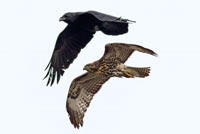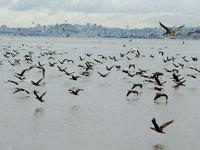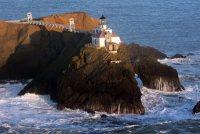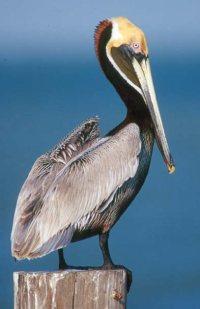Local Birding Sites: Southern Marin
Check back for regular updates and additional site profiles.
Hawk Hill- Jack Gedney, 9/16/15 Perched over the Golden Gate in the Marin Headlands, Hawk Hill rewards visitors with spectacular views, glimpses of history, and one of the greatest spectacles of fall migration. Funneled towards the narrowest bay-crossing point by the Marin peninsula, thousands of hawks and other birds flow by this point on their southward journey. During the peak of migration, usually falling in the last week of September or first week of October, a day on the hill can yield upwards of 800 sightings across more than a dozen species of raptors. Viewing continues to be rewarding further into fall, with increasing species diversity in mid- and late October. While the bulk of sightings are dominated by a few species (red-tailed hawk, sharp-shinned hawk, Cooper’s hawk—and turkey vulture), observers can also expect to see regular sightings of kestrels, merlins, peregrine falcons, red-shouldered hawks, broad-winged hawks, white-tailed kites, northern harriers, and ospreys. Some of the most impressive raptors such as bald eagles, golden eagles, and ferruginous hawks are low-volume but regular visitors to Hawk Hill. All of this activity is tracked every day from late August into early December by the dedicated volunteers of the Golden Gate Raptor Observatory, whose daily sightings can be tracked at their Daily Hawk Count. The regular presence of these observers plus additional birders drawn to the hill during the peak migration season means that any particularly exciting sightings will quickly be identified for all the visitors on the hill to enjoy. On September and October weekends, GGRO personnel present an informative “Hawk Talk” at noon and a banding demonstration around 1 PM (provided the hawks cooperate), showcasing a wild hawk temporarily captured at one of the nearby blinds to be fitted with an identifying leg band before being released. Of course, the rich natural habitats of the headlands host more birds than just the transient fly-overs. The coastal scrub that coats Hawk Hill and the surrounding area are home to quail, white-crowned sparrows, wrentits, blue-gray gnatcatchers, and other songbirds. For conservation biologists, Hawk Hill’s fame as a bird migration site is rivaled by its importance as vital habitat for the endangered Mission Blue Butterfly. The visible restoration work on the hill is driven by the need to protect the highly limited remaining populations, dependent on the native lupines which were displaced by a now-removed grove of Monterey pines planted on Hawk Hill. Beyond the hill itself, many hawks are year-round or winter residents in the Headlands and can be seen on a hike along the many nearby trails. Another popular birding site in close proximity is Rodeo Lagoon—a walk around the lagoon is a great complement to a visit to Hawk Hill, rewarding birdwatchers with both waterbirds and songbirds in the nearby trees. To get to Hawk Hill from the north, exit Highway 101 at Alexander Ave, the last Sausalito exit before the bridge. Stay to the left, turning left at the stop sign. Then turn right onto Conzelman Road. Continue into the hills on Conzelman, bearing left at the roundabout. There is roadside parking available before the final climb on foot up the hill, immediately before Conzelman begins its descent on a one-way road. Be aware that weekend parking may be crowded with visitors looking for photo opportunities. - Go to our Birding Sites Homepage - |
|
|
Red-tailed Hawk and Raven |
|
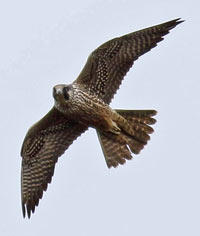
Peregrine Falcon by Don Bartling |
|
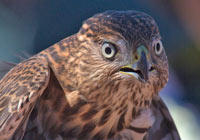 Cooper's Hawk at GGRO Banding Demonstration by Don Bartling Cooper's Hawk at GGRO Banding Demonstration by Don Bartling |
|
Richardson Bay- David Lukas The quiet arm of San Francisco Bay that lies between Sausalito and Tiburon is easily overlooked but it’s actually one of the premier birding spots in the Bay Area. Visit on a summer day and you’ll be lucky to see a single bird, but come back again between October and March (when the area is closed to boats) and you’ll see an incredible number and variety of waterbirds and shorebirds using the area to rest and feed. Formally known as Richardson Bay, this area attracts huge numbers of birds because the water is shallow and protected from the winds and currents that impact most of San Francisco Bay, and because Richardson Bay is rich with clams, shrimp, and other marine invertebrates. What this means is that on a winter day you can expect to see rafts of thousands of Greater and Lesser Scaup, Buffleheads, Ruddy Ducks, and Western Grebes stretching as far as you can see. And when the tide goes out the vast mudflats are taken over by egrets, gulls, and shorebirds ranging from tiny Least Sandpipers to towering Long-billed Curlews. But the best time to visit is late December to mid-February when herring lay their eggs in Richardson Bay and birds suddenly arrive in staggering numbers. There are magical days when there must be hundreds of thousands of birds feeding all at once—ducks diving and surfacing as fast as they can, flocks of hundreds of Double-crested Cormorants frantically circling the Bay, and more gulls than you can count raising an unbelievable ruckus—but even on quieter days most of these birds hang around resting and waiting for the next spawning event. The best part about Richardson Bay is that there are multiple viewing locations. The ideal starting point is Blackie’s Pasture just off of Tiburon Boulevard, where there are restrooms, benches for sitting and watching the spectacle, a freshwater creek where gulls, terns, and shorebirds gather to bathe, and a long walking path that follows the eastern shoreline of Richardson Bay. Other viewing points include the Richardson Bay Audubon Center on Greenwood Cove Drive, and a lovely little stretch of public walkway along Heron Drive in Strawberry. David Lukas is the author of Bay Area Birds, a field guide companion that tells the life histories of our local birds, covering habits of feeding, nesting, and migration, as well as where and when to see different bird species around the Bay Area. - Go to our Birding Sites Homepage - Point Bonita
- Don Kimball While most visit Point Bonita to visit its beautiful prominent landmark, the Point Bonita Lighthouse, there are other reasons to visit this windswept marine environment if you are a birder. Here you will find a mosaic of different habitats both marine and upland just waiting to be discovered. Each habitat hosts its own rich variety of bird species. Considering you will be combing the waters for seabirds a spotting scope is highly recommended. During the spring flocks of White-throated Swifts zoom upwardly on the updrafts created by the sheer cliffs at the oceans edge while White-crowned and Song Sparrows seem to be singing from every clump of wild mustard. Common Yellowthroats skulk amid the wet grasses and poison oak while Common Ravens ride the winds tumbling over and over for the sheer joy of it. For those who have difficulty differentiating between crows and ravens this is an excellent place to see ravens close up to view key field marks. Point Bonita is a great place to see cormorants of several species. Double-crested, Brandt’s, and even Pelagic can be observed here, each with its own specific field marks. Western and California Gulls are everywhere and one can spend hours scoping the choppy ocean waters to sort through the various seabirds. You should easily spot guillemots, murres, and a variety of sea ducks including scoters. This is one of the best locations locally where you can spot Black Oystercatchers. They are often heard long before they are seen. There have even been records of chicks hatching on the black craggy rocks below. Bird Rock’s guano covered surface is visible from almost anywhere and is a popular roost for Brown Pelicans and cormorants. Other birds of interest among the wet marshes nearby are swamp sparrows and rails. At this time of year a substantial variety of raptors can often be seen soaring over the headlands before moving on to southern climes. Coopers and Sharp-shinned Hawks are commonplace as are Red-tailed and Red-shouldered Hawks and occasional Peregrine Falcons, Golden Eagles, and others. Yellow-rumped warblers flit tirelessly in search of insects amid the trees while nuthatches of several species climb the trunks. Parking can be a bit of a challenge but with persistence one should be able to find a place to pull over and bird the area. Point Bonita is a famous landmark overlooking the Golden Gate Bridge and is easily located on most maps. - Go to our Birding Sites Homepage - |
Western Grebe |
|
Long-billed Curlew |
|
|
Double-crested Cormorants on Richardson Bay - Photo by Bob Hinz from Richardson Bay Audubon Center - Click for full size |
|
|
Point Bonita Lighthouse |
|
|
Black Oystercatcher |
|
|
Brown Pelican |



